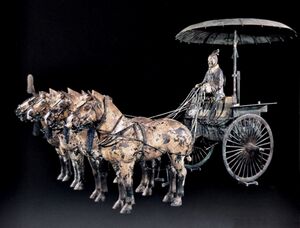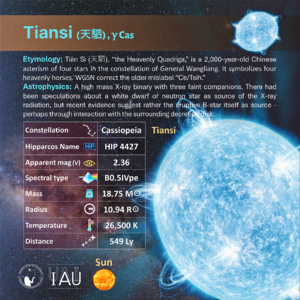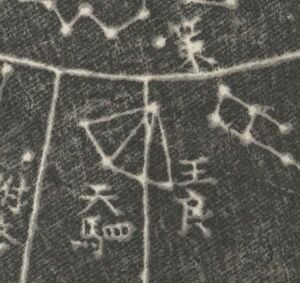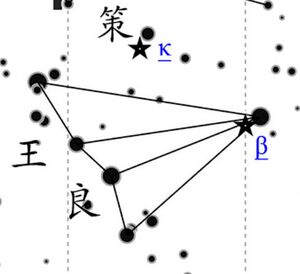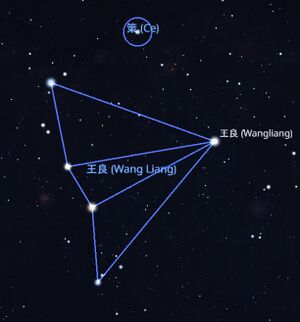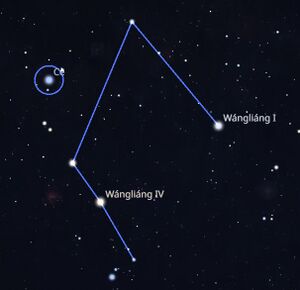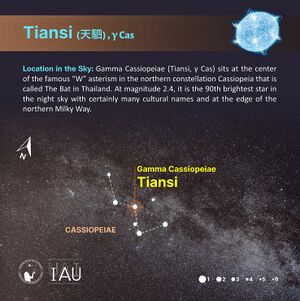Tiansi: Difference between revisions
Boshunyang (talk | contribs) mNo edit summary |
No edit summary |
||
| (2 intermediate revisions by 2 users not shown) | |||
| Line 1: | Line 1: | ||
{{DISPLAYTITLE: Tiansi (天駟)}} |
{{DISPLAYTITLE: Tiansi (天駟)}} |
||
[[File:Qin bronze chariot.jpg|thumb|Bronze chariot in Qin dynasty (220 BCE -206 BCE) with four hourses]] |
[[File:Qin bronze chariot.jpg|thumb|Bronze chariot in Qin dynasty (220 BCE -206 BCE) with four hourses]] |
||
[[File:Tiansi profileCard SadeghFaghanpour-IAU-WGSN.png|thumb|Tiansi profile card of modern star name (CC BY Sadegh Faghanpour for IAU-WGSN).]] |
|||
Tiān Sì (Heavenly Quadriga, 天駟) comprises four of the five stars forming the constellation [[Wangliang]] and represents the four horses pulling the chariot. It may thus be regarded as a constituent sub-constellation/asterism of [[Wangliang]]. |
Tiān Sì (Heavenly Quadriga, 天駟) comprises four of the five stars forming the constellation [[Wangliang]] and represents the four horses pulling the chariot. It may thus be regarded as a constituent sub-constellation/asterism of [[Wangliang]]. |
||
| Line 83: | Line 84: | ||
|} |
|} |
||
[[File:Tiansi stickfigure SadeghFaghanpour-IAU-WGSN.jpg|thumb|Tiansi stickfigure of modern star name (CC BY Sadegh Faghanpour for IAU-WGSN).]] |
|||
== Star Name Discussion (IAU) == |
== Star Name Discussion (IAU) == |
||
In |
In 2025, the name of the historical constellation Tiān Sì (Heavenly Quadriga, 天駟) was proposed for a star in its region, with discussion focusing on γ Cassiopeiae. |
||
On November 12, 2025 adopted the name Tiansi for γ Cas (27 Cas, HR 264, HD 5394, HIP 4427). γ Cas is a multiple system, and the name specifically refers to the massive primary star γ Cas Aa, which is a B0.5IVe star. The star is a famous eruptive variable, indeed the prototype of the γ Cas class, whose magnitude has varied historically between about magnitude 1.6 and 3.4. In recent years, the mean Johnson V magnitude has been around 2.17 (Smith & Henry 2021). |
|||
Decision: ... |
|||
==References == |
==References == |
||
| Line 95: | Line 98: | ||
[[Category:Asterism ]] |
[[Category:Asterism ]] |
||
[[Category:Constellation ]] |
[[Category:Constellation ]] |
||
[[Category:IAU-Star Name]] |
|||
[[Category:Eurasia]] |
[[Category:Eurasia]] |
||
[[Category:East Asian]] |
[[Category:East Asian]] |
||
[[Category:Chinese ]] |
[[Category:Chinese ]] |
||
[[Category:Cas]] |
|||
Latest revision as of 16:56, 16 November 2025
Tiān Sì (Heavenly Quadriga, 天駟) comprises four of the five stars forming the constellation Wangliang (王良) and represents the four horses pulling the chariot. It may thus be regarded as a constituent sub-constellation/asterism of Wangliang (王良).
Concordance, Etymology, History
Given the intimate cultural association between Tiansi and Wangliang, the two must have been conceived simultaneously. In their earliest stage, however, they might be regarded as distinct constellations, as recorded in the Tianguan shu (Book of Heaven Officials, 天官書). Only later, in the Shishi xing jing (Shi’s Star Canon, 石氏星經) later , were they formally unified into a single constellation under the name Wang Liang. Nevertheless, even long after their amalgamation, tradition continued to recognize the leftmost four stars of Wangliang as the “Quadriga” and some star map explicitly marked them as Tian Si.
It should be noted that the lodge Fang (the fourth of the Twenty-Eight Lodges) also bore the alternate name Tian Si (“Heavenly Quadriga”), a designation that had already been in use at least as early as the late sixth century BCE—earlier than the historical figure of Wang Liang himself. The only difference lies in that Fang comprises four stars representing the quadriga, yet it lacks a corresponding charioteer such as Wang Liang.
Identification of stars
| Star Names | Orders(Qing) | Ho PENG YOKE[1] | Yi Shitong[2]
Based on catalogue in 18th century |
Pan Nai[3]
based on Xinyixiangfayao Star Map and Huangyou Catalogue |
SUN X. & J. Kistemaker[4]
Han Dynasty |
Boshun Yang[5]
before Tang dynasty |
Boshun Yang[5]
Song Jingyou(1034) |
|---|---|---|---|---|---|---|---|
| Wangliang (王良) (Determinative) | 1st | beta Cas | beta Cas | beta Cas | beta Cas | beta Cas | beta Cas |
| Tiansi | 2nd | kappa Cas | kappa Cas | gamma Cas | gamma Cas | gamma Cas | gamma Cas |
| 3rd | gamma Cas | eta Cas | eta Cas | eta Cas | eta Cas | eta Cas | |
| 4th | eta Cas | alpha Cas | alpha Cas | alpha Cas | alpha Cas | alpha Cas | |
| 5th | alpha Cas | lambda Cas | zeta Cas | zeta Cas | zeta Cas | zeta Cas |
Maps (Gallery)
| historical map | modern identification
(Yang 2023) |
same in Stellarium 24.4 |
|---|---|---|
Star Name Discussion (IAU)
In 2025, the name of the historical constellation Tiān Sì (Heavenly Quadriga, 天駟) was proposed for a star in its region, with discussion focusing on γ Cassiopeiae.
On November 12, 2025 adopted the name Tiansi for γ Cas (27 Cas, HR 264, HD 5394, HIP 4427). γ Cas is a multiple system, and the name specifically refers to the massive primary star γ Cas Aa, which is a B0.5IVe star. The star is a famous eruptive variable, indeed the prototype of the γ Cas class, whose magnitude has varied historically between about magnitude 1.6 and 3.4. In recent years, the mean Johnson V magnitude has been around 2.17 (Smith & Henry 2021).
References
- ↑ P.-Y. Ho, “Ancient And Mediaeval Observations of Comets and Novae in Chinese Sources,” Vistas in Astronomy, 5(1962), 127-225.
- ↑ Yi Shitong伊世同. Zhongxi Duizhao Hengxing Tubiao中西对照恒星图表1950. Beijing: Science Press.1981: 56.
- ↑ Pan Nai潘鼐. Zhongguo Hengxing Guance shi中国恒星观测史[M]. Shanghai: Xuelin Pree. 1989. p226.
- ↑ Sun Xiaochun. & Kistemaker J. The Chinese sky during the Han. Leiden: Brill. 1997, Pp241-6.
- ↑ 5.0 5.1 B.-S. Yang杨伯顺, Zhongguo Chuantong Hengxing Guance Jingdu ji Xingguan Yanbian Yanjiu 中国传统恒星观测精度及星官演变研究 (A Research on the Accuracy of Chinese Traditional Star Observation and the Evolution of Constellations), PhD thesis, (Hefei: University of Science and Technology of China, 2023). 261.
